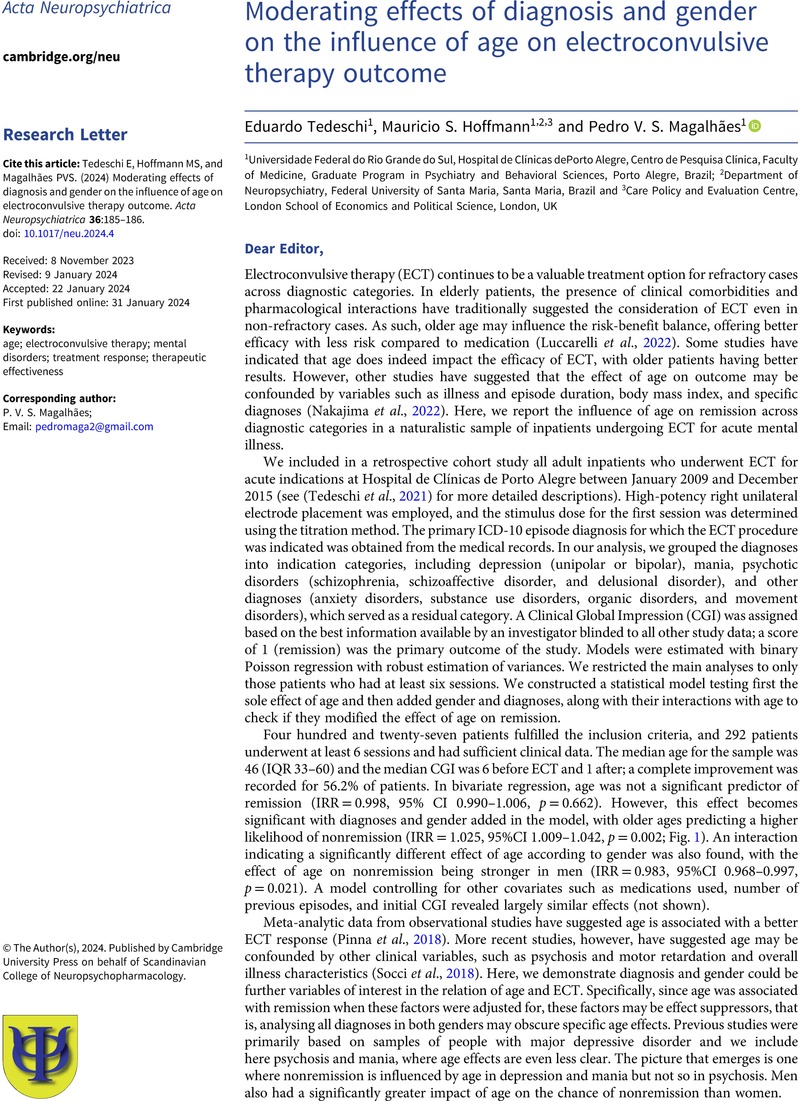No CrossRef data available.
Article contents
Moderating effects of diagnosis and gender on the influence of age on electroconvulsive therapy outcome
Published online by Cambridge University Press: 31 January 2024
Abstract
An abstract is not available for this content so a preview has been provided. Please use the Get access link above for information on how to access this content.

- Type
- Research Letter
- Information
- Copyright
- © The Author(s), 2024. Published by Cambridge University Press on behalf of Scandinavian College of Neuropsychopharmacology
References
Luccarelli, J, McCoy, TH, Seiner, SJ, & Henry, ME (2022) Real-world evidence of age-independent electroconvulsive therapy efficacy: a retrospective cohort study. Acta Psychiatrica Scandinavica 145(1), 100–108.10.1111/acps.13378CrossRefGoogle ScholarPubMed
Nakajima, K, Takamiya, A, Uchida, T, Kudo, S, Nishida, H, Minami, F, Yamamoto, Y, Yamagata, B, Mimura, M, & Hirano, J (2022) Individual prediction of remission based on clinical features following electroconvulsive therapy: a machine learning approach. The Journal of Clinical Psychiatry 83(5), 21m14293. doi: 10.4088/JCP.21m14293.CrossRefGoogle ScholarPubMed
Pinna, M, Manchia, M, Oppo, R, Scano, F, Pillai, G, Loche, AP, Salis, P, & Minnai, GP (2018) Clinical and biological predictors of response to electroconvulsive therapy (ECT): a review. Neuroscience Letters 669, 32–42.10.1016/j.neulet.2016.10.047CrossRefGoogle ScholarPubMed
Socci, C, Medda, P, Toni, C, Lattanzi, L, Tripodi, B, Vannucchi, G, & Perugi, G (2018) Electroconvulsive therapy and age: age-related clinical features and effectiveness in treatment resistant major depressive episode. Journal of Affective Disorders 227, 627–632.10.1016/j.jad.2017.11.064CrossRefGoogle ScholarPubMed
Tedeschi, EA, Patusco, LM, Zahler, S, Martini, M, Chiavaro da Fonseca, R, & Magalhães, PVS (2021) Factors associated with seizure adequacy along the course of electroconvulsive therapy. The journal of ECT 37(1), 46–50.10.1097/YCT.0000000000000716CrossRefGoogle ScholarPubMed





